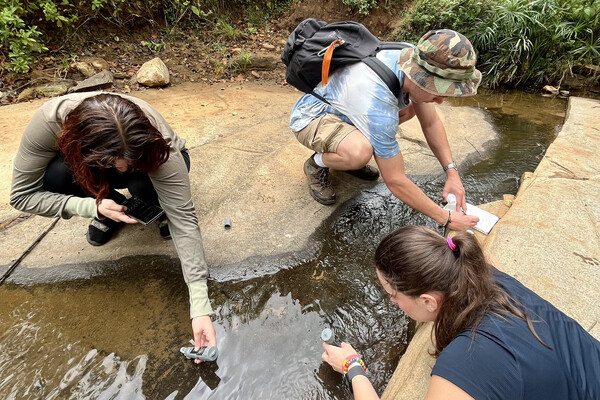
Griffin Pitt, right, works with two other student researchers to test the conductivity, total dissolved solids, salinity, and temperature of water below a sand dam in Kenya.
(Image: Courtesy of Griffin Pitt)
 Ina Dobrinski, left, has discovered a new approach to transgenesis in large animals, including goats like this one, tended by Research Technician Mark Modelski.
Ina Dobrinski, left, has discovered a new approach to transgenesis in large animals, including goats like this one, tended by Research Technician Mark Modelski.For more than a decade, scientists have known that transgenesis—the integration of foreign genes into a living organism—was possible in small rodents. For that reason, most such research was conducted on mice.
But now, Ina Dobrinski, associate professor and the director of the Center for Animal Transgenesis and Germ Cell Research at Penn's School of Veterinary Medicine has led a study that used a harmless gene therapy process to transfer a genetic modification to male reproductive cells of mice and goats. The virus then was passed on naturally to offspring.
“It’s exciting that we could really prove it works,” Dobrinski says. “It’s taken a long time to adopt this technology from mice to a large animal species.”
Germ cell transplantation is a process in which scientists isolate stem cells in the testes, where sperm are made, then put them into the testes of another animal, explains Dobrinski. The stem cells colonize in the recipient, begin making sperm, then carry the genetic material of the donor even though the recipient provides the environment.
In the Penn study, researchers mated the recipient males with wild-type females, and found that genetic modification had been passed on to 10 percent of the offspring. They only carried the process through to the embryonic stage—no animals were created.
The virus used in the research, AAV, is a dependent virus that carries no disease and causes only a very mild response from the immune system. Because it can infect both dividing and non-dividing cells and passes its genome, it is considered an excellent candidate for use in gene therapy.
“Initially, the team used the established germ cell transplantation model in the mouse to investigate whether AAV-mediated transduction of germ cells was possible and could result in transgene transmission,” Dobrinski said. “To broaden the applicability of the result for different mammalian species, the approach was then applied to a large animal species in which germ cell transplantation-mediated transgenesis would provide an important alternate approach to the generation of transgenic animal models for biomedical research.”
The findings are important for many reasons, Dobrinski says. Animals can produce pharmaceutical substances in their milk, and in fact, a drug that uses protein produced in the milk of transgenic goats has just been approved for use in Europe.
“When you think about how drugs are made, they’re made in bacteria or cell cultures. Complex proteins can’t be made very well,” she says. “The only other source we had so far was human blood, which of course has many issues. There’s a shortage; you have HIV. Dairy animals, that’s what they do for a living, make large amounts of proteins in their milk,” she says. There’s also the possibility of creating animals resistant to certain diseases. To date, the standard method of making genetically altered animals other than mice has been cloning, a system that is inefficient. The study, which will appear in the February 2008 edition of The FASEB Journal, doesn’t put the matter to rest, but provides a starting point to potentially make the process more efficient and cost-effective.
“Now that we’ve shown, yes, you can actually do it, there are a lot of application questions,” Dobrinski says. “Instead of using a [harmless] gene, can we make a goat that can make important protein in its milk?”

Griffin Pitt, right, works with two other student researchers to test the conductivity, total dissolved solids, salinity, and temperature of water below a sand dam in Kenya.
(Image: Courtesy of Griffin Pitt)

Image: Andriy Onufriyenko via Getty Images

nocred

Provost John L. Jackson Jr.
nocred